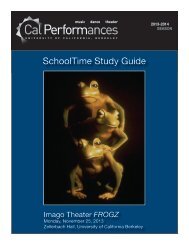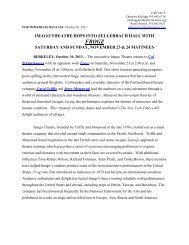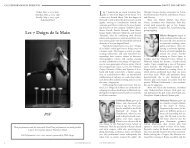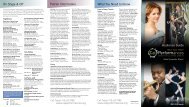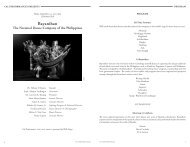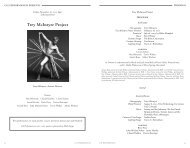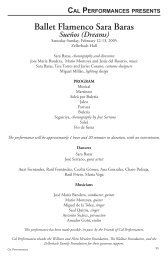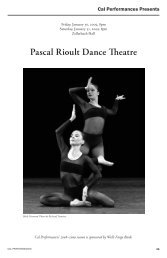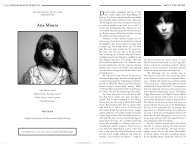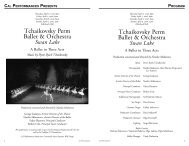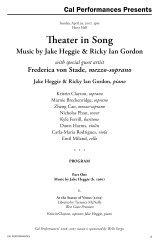Ballet Folklorico ?Quetzalli? de Veracruz - Cal Performances
Ballet Folklorico ?Quetzalli? de Veracruz - Cal Performances
Ballet Folklorico ?Quetzalli? de Veracruz - Cal Performances
Create successful ePaper yourself
Turn your PDF publications into a flip-book with our unique Google optimized e-Paper software.
CAL PERFORMANCES PRESENTS<br />
14<br />
Sunday, May 2, 2010, 3pm<br />
Zellerbach Hall<br />
<strong>Ballet</strong> <strong>Folklorico</strong> “<strong>Quetzalli</strong>” <strong>de</strong> <strong>Veracruz</strong><br />
25th Anniversary Tour<br />
with Special Musical Guests<br />
Tlen-Huicani<br />
“<strong>Quetzalli</strong>” extends special thanks to the Department of Tourism and Culture, State of <strong>Veracruz</strong>:<br />
Governor Lic. Fi<strong>de</strong>l Herrera Beltran and Angel Alvaro Peña, Secretary of Tourism and Culture.<br />
<strong>Cal</strong> <strong>Performances</strong>’ 2009–2010 season is sponsored by Wells Fargo.<br />
CAL PERFORMANCES<br />
CAL PERFORMANCES<br />
PROGRAM<br />
Ancient Mexico: Danzas <strong>de</strong> Concheros<br />
Paso <strong>de</strong> Camino (“Pass in the Road”)<br />
Aguila Blanca (“White Eagle”)<br />
Ozomatli<br />
Xipe<br />
Guerrero<br />
Musical Interlu<strong>de</strong><br />
Tierra <strong>de</strong> Revolución (“Land of Revolution”)<br />
El Becerrero (“The <strong>Cal</strong>f”)<br />
La Gallina (“The Hen”)<br />
Musical Interlu<strong>de</strong> Tlen-Huicani<br />
Baja <strong>Cal</strong>ifornia Norte<br />
La Loba <strong>de</strong>l Mal (“The Bad Wolf”)<br />
Arrieando Vacas (“Rounding Up the Cows”)<br />
Sopa <strong>de</strong> Pelícanos (“Pelican Soup”)<br />
INTERMISSION<br />
<strong>Veracruz</strong>: Huasteca (Indigena)<br />
Procesión <strong>de</strong> la Virgen (“Procession of the Virgin”)<br />
Danza <strong>de</strong> Chules<br />
Fandanguito<br />
Musical Interlu<strong>de</strong> Tlen-Huicani<br />
<strong>Veracruz</strong>: Sotavento (Jarocho)<br />
Musical Interlu<strong>de</strong><br />
El Jaqueton (“The Braggart”)<br />
El Trompo (“The Spinning Top”)<br />
La Bruja (“The Witch”)<br />
La Bamba (Traditional)<br />
The program is subject to change.<br />
PROGRAM<br />
15
PROGRAM NOTES<br />
<strong>Ballet</strong> <strong>Folklorico</strong> “<strong>Quetzalli</strong>” <strong>de</strong> <strong>Veracruz</strong><br />
Ancient Mexico: Danza <strong>de</strong> Concheros<br />
The “danza <strong>de</strong> concheros” or “danza <strong>de</strong> conquista” is<br />
one of the most vigorous and faithfully preserved<br />
traditions that exist in Mexico today. This dance is<br />
only one of numerous ceremonies that make up a<br />
great complex ritual. The dancers are <strong>de</strong>scendants<br />
of the prehispanic populations that existed in the<br />
country, and the dances were employed as a way to<br />
spread the Christian religion by the Spanish conquerors.<br />
With the shout, “He is God!” the dance<br />
would begin, accompanied by guitars ma<strong>de</strong> from<br />
the shells of armadillos, from which the name<br />
of the dance is <strong>de</strong>rived (concha means shell). It is<br />
believed that this dance originates from the early<br />
days of the Spanish conquest. According to legend,<br />
when the most ferocious part of the battle between<br />
the Spaniards and the indigenous Chichimecas was<br />
taking place, a cross appeared in the sky followed<br />
by the figure of the apostle James. These dances<br />
can still be witnessed today in the sacred places of<br />
the indigenous populations, such as the Cathedral<br />
in Mexico City (built over an ancient temple) and<br />
in front of the pyramids.<br />
Guerrero<br />
The state of Guerrero lies along the West Coast of<br />
Mexico and inclu<strong>de</strong>s the colorful mountain town<br />
of Taxco and the tourist capital of the country,<br />
Acapulco. These dances come from the region<br />
known as tierra caliente (“hot land”), which inclu<strong>de</strong>s<br />
the eastern part of the state as well as parts<br />
of Michoacan and Morelos. The most popular<br />
forms of music in the region are the sones and gustos.<br />
The instrumentation is normally violins, guitars,<br />
a drum with a snare or rasp, and sometimes a<br />
harp. The dances are always performed by couples<br />
and <strong>de</strong>monstrate the flirtatious relationship between<br />
man and woman. The dress is very colorful,<br />
as is the region, emphasizing a close relationship<br />
to nature as indicated by the names of the dances,<br />
such as “the calf,” “the hen,” etc.<br />
16<br />
Baja <strong>Cal</strong>ifornia Norte<br />
The baile <strong>de</strong>l calabaceado is a very popular manifestation<br />
of the cattlemen of this region, the northern<br />
part of the Baja peninsula that bor<strong>de</strong>rs southern<br />
<strong>Cal</strong>ifornia. This dance, also known as the “cowboy<br />
dance,” was born in the late 1950s as the norteña<br />
musical style began to gain popularity. The rhythm<br />
allows the dancers to interpret various movements<br />
of the cowboys including jumps, turns and kicks<br />
all with the intention of creating a cloud of dust<br />
un<strong>de</strong>rneath their boots.<br />
<strong>Veracruz</strong><br />
Huasteco Region (Indigenous)<br />
This region, encompassing several states, is the<br />
home of the Huastec culture, which dates back<br />
to the early part of the previous millennium. The<br />
Christian religion was introduced to the indigenous<br />
cultures in the 1500s by the Spanish conquerors,<br />
but the ceremonies retain elements of the<br />
Native American culture. The procession para<strong>de</strong>s<br />
the Virgin of Guadalupe on a platform, or in this<br />
case her image on a banner, around the town; she<br />
then takes her place on a pe<strong>de</strong>stal to presi<strong>de</strong> over<br />
the festivities. The participants ren<strong>de</strong>r their tribute<br />
the “Queen of the Americas” with their contrite<br />
but rhythmic passes. These are often celebrated on<br />
December 12, the day of the Virgin.<br />
Sotavento: Fandango Jarocho<br />
The jarocho people, cheerful by nature, make<br />
their day-to-day lives a continual fiesta—each<br />
street and each home is a likely place to celebrate.<br />
In February, the Adoration of the Virgin of the<br />
Can<strong>de</strong>laria; the Fiesta of the Crosses in May; in<br />
December, Las Posadas or La Rama; a birthday, or<br />
a wedding—all are celebrated to the rhythm of the<br />
son. The celebrations are still faithfully preserved<br />
in communities such as Tlacotalpan and Boca <strong>de</strong>l<br />
CAL PERFORMANCES<br />
Rio; a young child easily remembers her grandmother<br />
dressing her in a new white outfit and sandals<br />
urging, “Hurry little one, we’re going to the<br />
Fandango, the fiesta is about to start!” The strong<br />
influence of the Spanish is evi<strong>de</strong>nt in the music, the<br />
dance steps, and in the dress. The term jarocho was<br />
used to <strong>de</strong>scribe the native mestizo population living<br />
around the port city of <strong>Veracruz</strong> and the coastal<br />
plain region. The name comes from an Arabic<br />
word meaning “filth” or “dirty,” which is how the<br />
conquering Spaniards viewed the natives. But over<br />
the years, the term has come to be recognized as a<br />
source of pri<strong>de</strong> for the people of Sotavento, whose<br />
ancestry is a mix of European, African and indigenous<br />
peoples. The music is gay and lively and led<br />
by the harp, the characteristic instrument of the<br />
region. “La Bamba,” also known as el hymno veracruzano<br />
(anthem of <strong>Veracruz</strong>), is one of the region’s<br />
ol<strong>de</strong>st and most recognizable melodies. It dates<br />
back at least 300 years and incorporates the bright<br />
ribbons that the dancers <strong>de</strong>licately maneuver into a<br />
bow—using only their feet.<br />
CAL PERFORMANCES<br />
PROGRAM NOTES<br />
17
ABOUT THE ARTISTS<br />
o u n d e d in 1985 by Maestro Hugo Betancourt,<br />
F<strong>Ballet</strong><br />
<strong>Folklorico</strong> “<strong>Quetzalli</strong>” <strong>de</strong> Verzcruz<br />
makes its home in the state capital, Xalapa,<br />
<strong>Veracruz</strong>. They have toured internationally performing<br />
traditional folkloric dances as well as<br />
their Afro-Caribbean spectacular, Carnaval<br />
<strong>Veracruz</strong>ano. The company has been the official<br />
representatives for Secretary of Tourism and<br />
Economic Development for the State of <strong>Veracruz</strong><br />
since 1986, having given hundreds of performances<br />
across Mexico and the United States, South<br />
America, Asia, Europe and the Caribbean. They<br />
have performed at the Carnaval of <strong>Veracruz</strong> every<br />
year since 1991, as well as taking their famous comparsa<br />
xalapeña to the Carnival of Havana in Cuba<br />
on three different occasions. Other important<br />
appearances inclu<strong>de</strong> the Miss Mexico pageant in<br />
Cancún, TV appearances on Siempre en Domingo<br />
from Mexico City, the Festival Cervantino in<br />
Guanaguato and the Festival of Culture in Kuala<br />
Lumpur, Malaysia. They have recently performed<br />
in Peru, Spain, Germany, Taiwan and Canada.<br />
Currently, the group operates a school and training<br />
program for young dancers in Xalapa. “<strong>Quetzalli</strong>”<br />
continues to be one of the great cultural treasures of<br />
<strong>Veracruz</strong>, performing to thousands of people every<br />
year. “<strong>Quetzalli</strong>” hosted the National Association<br />
of Grupos <strong>Folklorico</strong>s (ANGF) for the third time<br />
in summer 2003. This year marks the group’s 25th<br />
anniversary, which inclu<strong>de</strong>s a U.S. tour and a gala<br />
performance in its home city of Xalapa, at the<br />
Teatro <strong>de</strong>l Estado.<br />
Born in the northern region of <strong>Veracruz</strong> known as<br />
La Huasteca, Hugo Betancourt Morales was exposed<br />
to folk music and dance at an early age. His<br />
uncle, Humberto Betancourt, was a well-known<br />
musician and composer, and he shared his great<br />
passion for the art and culture of his homeland<br />
with his nephew. Maestro Betancourt studied folklorico<br />
dance un<strong>de</strong>r Maestro Alejandro Gomez Solis<br />
in the <strong>Ballet</strong> <strong>Folklorico</strong> “<strong>Veracruz</strong>” sponsored by<br />
the Department of Popular Education. He toured<br />
the United States on several occasions, with that<br />
group and with <strong>Ballet</strong> <strong>Folklorico</strong> “Tonanzintla.”<br />
18<br />
In 1985, along with Rosalinda Perez and Manuel<br />
Vasquez, he formed “<strong>Quetzalli</strong>” and began to<br />
assemble a repertoire and collect costumes and<br />
resources. He has served on the board for the<br />
National Association for Grupos <strong>Folklorico</strong>s (USA)<br />
and coordinated their international conference on<br />
two occasions in Xalapa. Un<strong>de</strong>r the direction of<br />
Maestro Betancourt, “<strong>Quetzalli</strong>” has grown from<br />
eight dancers to a company of more than 45 with<br />
its own training school. Maestro Betancourt has<br />
been recognized by the <strong>Veracruz</strong> government for<br />
his great contribution to the company and to the<br />
cultural panorama of <strong>Veracruz</strong>. He and his wife,<br />
Alejandra, are the proud parents of two children,<br />
Arantxa and Hugo <strong>de</strong> Jesus.<br />
<strong>Ballet</strong> <strong>Folklorico</strong> “<strong>Quetzalli</strong>” <strong>de</strong> <strong>Veracruz</strong><br />
Dancers<br />
Citlalli Roldan<br />
Maria Acitlalli Muñoz<br />
Jacqueline Dorantes<br />
Nancy M. Gomez<br />
Diana Luz Gonzalez<br />
Amairany Cortes<br />
Saul Ceballos<br />
Uriel De J. Martinez<br />
Carlos A. Soto<br />
Jose Miguel Montano<br />
Carlos Gonzalez<br />
Victor Velasquez<br />
Artistic Director Hugo Betancourt<br />
Musical Directors David Melgarejo,<br />
Alberto <strong>de</strong> la Rosa<br />
Assistants Saul Ceballos,<br />
Carlos A. Soto<br />
Tour Coordination SRO Artists, Inc.<br />
Tour Production Manager George Cruze<br />
Artist Management Steve Heath, At Home<br />
Artist Management<br />
CAL PERFORMANCES<br />
o u n d e d in 1973 at the State University of<br />
F<strong>Veracruz</strong><br />
in Xalapa, Tlen-Huicani has been<br />
consi<strong>de</strong>red one of the most faithful representatives<br />
of the folklore of <strong>Veracruz</strong> existent today. Un<strong>de</strong>r the<br />
direction of Maestro Alberto <strong>de</strong> la Rosa Sánchez,<br />
Tlen-Huicani, which means “the singers” in the<br />
indigenous Nahuatl language, has performed in<br />
more than 50 different countries and has captured<br />
and preserved much of the music of the “Jarocho”<br />
and “Huasteco” styles in a number of recordings,<br />
and radio and television performances. While specializing<br />
in the music of their homeland, Grupo<br />
Tlen Huicani has also explored many different<br />
musical genres in Latin America, especially those<br />
which incorporate the folk harp. Most recently,<br />
Tlen-Huicani has ad<strong>de</strong>d concerts with orchestra to<br />
their long list of experiences, performing special arrangements<br />
of the traditional melodies of <strong>Veracruz</strong><br />
with symphonies in Mexico and the United States.<br />
The arrangements were created especially for the<br />
group by Maestro Mateo Oliva, taking advantage<br />
of its unique style and sound.<br />
Tlen-Huicani has ma<strong>de</strong> numerous recordings,<br />
four of which have been released in the United<br />
States. Their longstanding contribution to the musical<br />
landscape in Mexico resulted in their being<br />
named “best folk music group in Mexico” by the<br />
Union of Music and Theater Critics of Mexico.<br />
In 1998, they were honored for celebrating 25<br />
years of service to the <strong>de</strong>velopment of the culture<br />
of <strong>Veracruz</strong>, with <strong>de</strong>clarations from the governor<br />
of <strong>Veracruz</strong>, the rector of the state university and<br />
many distinguished guests. They have also been<br />
invited to represent Mexico on several occasions<br />
at various World Harp Conferences, including the<br />
2002 conference in Geneva, Switzerland. In 2005,<br />
the Mid-Atlantic Arts Foundation, in coordination<br />
with the National Endowment for the Arts,<br />
provi<strong>de</strong>d funding for two regional tours as part of<br />
the Mexican Initiative Program. At the 2007 San<br />
Jose Mariachi Festival, Tlen-Huicani performed<br />
alongsi<strong>de</strong> Linda Ronstadt and Los Lobos.<br />
CAL PERFORMANCES<br />
ABOUT THE ARTISTS<br />
Among the high artistic values (especially in folkloric<br />
music) of <strong>Veracruz</strong> and Mexico, Alberto <strong>de</strong><br />
la Rosa Sánchez stands out as one of its shining<br />
stars. In 1973, he formed Tlen-Huicani, <strong>de</strong>dicated<br />
to the folkloric music of Mexico and Latin<br />
America and with whom he has traveled much of<br />
the mo<strong>de</strong>rn world. His travels to South America<br />
with the group “<strong>Veracruz</strong>” had a great impact on<br />
the type of musicians who would join the group<br />
and, in fact, led to the group becoming specialist<br />
in the folklore of South America (as well as that of<br />
Mexico). The contacts established on the continent<br />
have been very valuable in offering authenticity to<br />
their magnificent interpretations. Tlen-Huicani<br />
was established with its entire thrust revolving<br />
around the harp, and it is a beautiful gift to the<br />
mind and spirit to hear them perform.<br />
Besi<strong>de</strong>s his duties with Tlen-Huicani, Maestro<br />
Alberto is also musical director for the <strong>Ballet</strong><br />
<strong>Folklorico</strong> of the Universidad <strong>Veracruz</strong>ana (State<br />
University of <strong>Veracruz</strong>). He has been a soloist at<br />
festivals and concert halls around the world and<br />
has also been a much sought-after instructor and<br />
clinician specializing in the music of the Latin-<br />
American harp. He has been influential in establishing<br />
the Encuentro <strong>de</strong> Harpa in his hometown<br />
of Xalapa and for bringing internationally recognized<br />
harpists from around the world to perform<br />
there. Through his success with the group and as a<br />
soloist, Maestro Alberto remains in great <strong>de</strong>mand<br />
throughout Mexico, the Americas and around the<br />
world.<br />
Grupo “Tlen-Huicani”<br />
Alberto <strong>de</strong> la Rosa harp, requinto, vocals<br />
Raul Monge percussion, jarana, vocals<br />
Ruben Melgarejo bass, violin, vocals<br />
Miguel Lopez Sánchez guitar, vocals<br />
19



